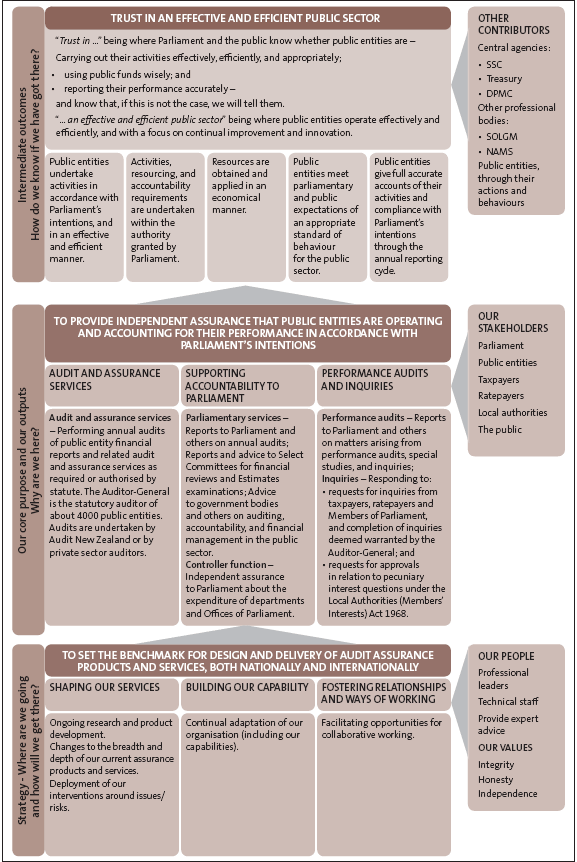Part 2: Strategic direction and operating intentions
Our desired overall outcome is trust in the effectiveness and efficiency of the public sector. The Auditor-General helps create trust in the effectiveness and efficiency of the public sector by providing independent assurance and advice to Parliament and the public that governance and management arrangements are suitable to address five main areas1 - our intermediate outcomes - and where they are not by saying so. These five main areas are that public entities:
- carry out activities in keeping with Parliament’s intentions, and in an effective and efficient manner;
- carry out activities, resourcing, and accountability requirements within the authority granted by Parliament;
- obtain and apply resources in an economical manner;
- meet parliamentary and public expectations of an appropriate standard of behaviour for the public sector; and
- give full and accurate accounts of their activities, and of their compliance with Parliament’s intentions, through the annual reporting cycle.
We gather the information necessary to provide this independent advice and assurance through our output classes:
- Audit and assurance services - performing audit and related assurance services as required or authorised by statute. The Auditor-General is required to audit the Financial Statements of the Government, public entities’ financial statements, and other information that must be audited.
- Supporting accountability to Parliament - providing advice and assistance to select committees and other stakeholders, and performing the Controller function. Through this function, the Office provides independent assurance to Parliament that departments and Offices of Parliament have incurred expenses and capital expenditure for purposes that are lawful and within the scope, amount, and period of the appropriation or other authority.
- Performance audits and inquiries - carrying out, and reporting on, performance audits and inquiries of public entities under the Public Audit Act 2001 and responding to requests for approvals of pecuniary interest questions regulated by the Local Authorities (Members’ Interests) Act 1968.
Outcome, impact, and output performance measures and standards
Our outcome measure of trust in the effectiveness and efficiency of the public sector is that New Zealand’s Transparency International Corruption Perception index score over the next three years is maintained or improved. In 2006, New Zealand’s score was 9.6, meaning it ranked first equal on the index with Finland and Iceland.
We are currently considering two other sources of possible future outcome measures:
- The Gallup Corruption Index survey asks respondents about business and government corruption. In the survey’s overall results, New Zealand ranks well among the 101 countries in which it is conducted, sharing second to lowest place with Denmark, behind Finland.
- Each year, the State Services Commission produces a report - State of the Development Goals. The sixth development goal is “Trusted State Services: Strengthen trust in the State Services, and reinforce the spirit of service”.
In Part 3, we set out our output classes and their associated impact and performance measures and standards. We describe:
- the impact measures we use to help us understand whether our outputs are having the effect we want (as required by section 40(d)(i) of the Public Finance Act 1989); and
- the performance measures and standards we use to help us understand whether we are producing quality outputs within time and resource constraints (as required by section 41(1)(e)(ii) of the Public Finance Act 1989).
If our output performance and our outcome and output impact measures results match those projected in this plan, we will be contributing to an effective and efficient public sector that is trusted within the five areas that form the Auditor-General’s mandate under the Public Audit Act 2001.
A failure to achieve satisfactory performance against an output standard or budget, a failure to maintain a static situation, or a trend in the opposite direction to that desired in outcome measures could indicate a cost-effectiveness2 issue that we would explore and plan to improve.
It is worth noting that about 85% of the Auditor-General’s expenditure is on audit and assurance services. These are primarily annual audits. To assess the effectiveness of annual audits, our performance measures include:
- ensuring that audits are completed within a reasonable time and that arrears in completing audits are not caused by inaction on our part;
- issuing timely management reports;
- achieving client satisfaction with the quality of the work of our audit service providers;
- obtaining assurance about the quality of annual audit work; and
- obtaining independent confirmation of the probity and objectivity of the methods and systems that we use to allocate and tender audits and monitor the reasonableness of audit fees.
Our outcome measures focus on the effectiveness of this work by comparing the numbers of audits completed according to statutory timelines, audit qualifications, and the response of entities to management letter recommendations with data from the previous two years.
Figure 2 summarises our outcomes, our outputs, and our strategy.
Figure 2
Our outcomes, outputs, and strategy

1: These five main areas reflect the mandate given to the Auditor-General in the Public Audit Act 2001.
2: See section 40(d)(ii) of the Public Finance Act 1989.
page top